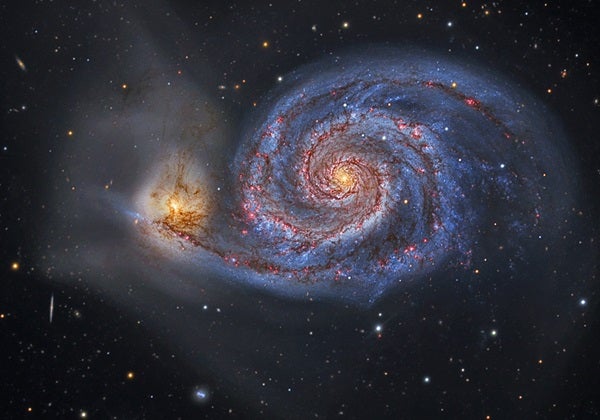Charles Messier discovered M51 on Oct. 13, 1773; the following January, he recorded it as a “very faint nebula without any stars.” In the 1784 Connaissance des Temps, Messier appended a reference to Pierre Méchain’s observation that M51, in fact, appeared to be a double galaxy with two nuclei. We now know that M51’s companion is a diffuse disk galaxy, NGC 5195, that is interacting with it.
Not until 1845 did William Parsons, Earl of Rosse, detect the nebula’s “spiral convulsions” with his 72-inch speculum mirror reflector at Birr Castle in Ireland, making M51 the first galaxy shown to have spiral structure. This revelation led to the belief that Rosse had discovered a solar system in formation — a notion that was not shattered until 1923, when astronomers learned the true nature of the mysterious spiral nebulae.
The M51-NGC 5195 pair of galaxies lies 27 million light-years away. M51 is the grander of the two, measuring nearly 90,000 light-years across and shining with a luminosity of about 10 billion suns. NGC 5195 is a small disk galaxy some 55,000 light-years across. It most likely made its closest pass by M51 some 70 million years ago and is now receding from us at a rate of 290 miles per second (467 kilometers per second).
To find these fascinating galaxies, look about 2° south-southwest of 24 Canum Venaticorum. M51 is an 8th-magnitude circular glow (11′ by 7′), and NGC 5195 appears as a 6′ “knot” a little less than 5′ north of M51’s nucleus.
M51’s spiral structure teases the eye through telescopes smaller than 8 inches in aperture. Larger telescopes bring out the arms, which appear to encircle the nucleus. With patience, those branches break down into finer patches of star-forming regions. Telescopes 10 inches or larger will also clearly show the dusty bridge slicing across NGC 5195’s face — a telling sign that the smaller galaxy is receding from the larger.
Make sure to explore Astronomy’s full list of 101 cosmic objects you must see. New entries will be added each week throughout 2022.
To get the latest astronomical news and observing content delivered directly to your door, subscribe to Astronomy magazine today!










